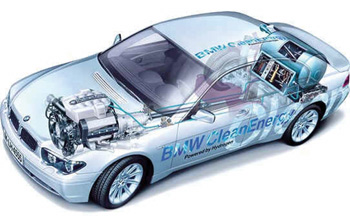![[Metroactive Features]](/features/gifs/feat468.gif)
[ Features Index | Silicon Valley | Metroactive Home | Archives ]

Rev Hydrogen Redux Hydrogen can be made by electrolysis: splitting water. And the energy for this process could come from wind or solar power. By Novella Carpenter SCHWARZENEGGER promised a hydrogen highway in April 2004, then we all promptly forgot about it. At least I did. But just as I'd dismissed the fuel, I wondered if I should revisit the technology when I got wind of the National Hydrogen Association's 17th annual Conference and Expo in held in Long Beach last week. Not that I attended. But I got the second-best thing: Patrick Serfass, the director of technology and program development at the National Hydrogen Association, on the phone. He was my hydrogen conference Cliffs Notes. Serfass' voice expressed the giddy delight that these kinds of conferences can spawn. Though he probably wanted to tell me all about the little details—new compressors and break-away valves—I wanted the big picture. The theme of the meeting was Global Progress Toward Green Energy, he told me, and attendance was up, with 25 countries representing and representatives from 44 out of 50 states. The EU! Singapore! Canada! China promised to start running 20,000 hydrogen buses by 2020. Polynesia's president, Temura, expressed his country's interest in developing a hydrogen economy. Serfass pointed out this had to do with economics—on an island without natural resources, hydrogen makes sense. But why should you care, if hydrogen seems to be sucky because it will take too long to get to the consumer, is only as clean as the technology that makes the hydrogen itself—and a wonk like Arnold is behind it? It is true that hydrogen has been made mostly from a nonrenewable resource, natural gas. But Serfass pointed out that this is because, in the past, H2 was being made to clean sulfur out of gas or to make ammonia for fertilizer. Those industries have access to natural gas and are less likely to try clean methods like solar or wind to make hydrogen. But if using natural gas to generate hydrogen is the cheapest method, why would a company do something different? Serfass pointed out that in places like California, our goal is to improve air quality by reducing emissions, so this may guide the direction of hydrogen production. Hydrogen can be made by electrolysis: splitting water. And the energy for this process could come from wind or solar power. In Scotland, there's a green car running on wind-power-generated hydrogen. The Pure Energy Center vehicle zooms around Shetland, the land of wool and wind. The area has always generated excess wind energy but the problem was storage. Now the energy goes into electrolysis, which makes hydrogen to power up fuel cells. I had also previously poo-poo'd the concept of hydrogen fueling stations, but just one look at the Hydrogen Highway website's (hydrogenhighway.ca.gov) map of all the hydrogen fueling stations offers some hope. There are a few green dots, which means the stations actually exist, and even more yellow dots signifying more stations to come. Though for the most part they are centered in the Bay Area and the Los Angeles area, at least it's a start. Though Serfass said it won't be until 2015 that passenger cars powered by hydrogen will be widely available, he thinks the industry might speed things up In 2010, GM and BMW plan to release hydrogen cars. A few companies like Hydrogen Car Company (H2carco.com) convert vehicles, called H²ICE (hydrogen internal-combustion engines) to simply burn hydrogen. This is different from a hydrogen fuel-cell system, which releases H²O as its only waste product. The H²ICE cars don't release any carbon dioxide or carbon monoxide, but do let out some NO² (a precursor to smog). So, not perfect, but still a move in the right direction. Let the record, show, then, that I'm cautiously stripping off my hydrogen cynicism, and opening myself up to the world of the hydrogen molecule.
Send a letter to the editor about this story to letters@metronews.com. [ Silicon Valley | Metroactive Home | Archives ]
|
From the March 22-28, 2006 issue of Metro, Silicon Valley's Weekly Newspaper.
Copyright © 2006 Metro Publishing Inc. Metroactive is affiliated with the Boulevards Network.
For more information about the San Jose/Silicon Valley area, visit sanjose.com.